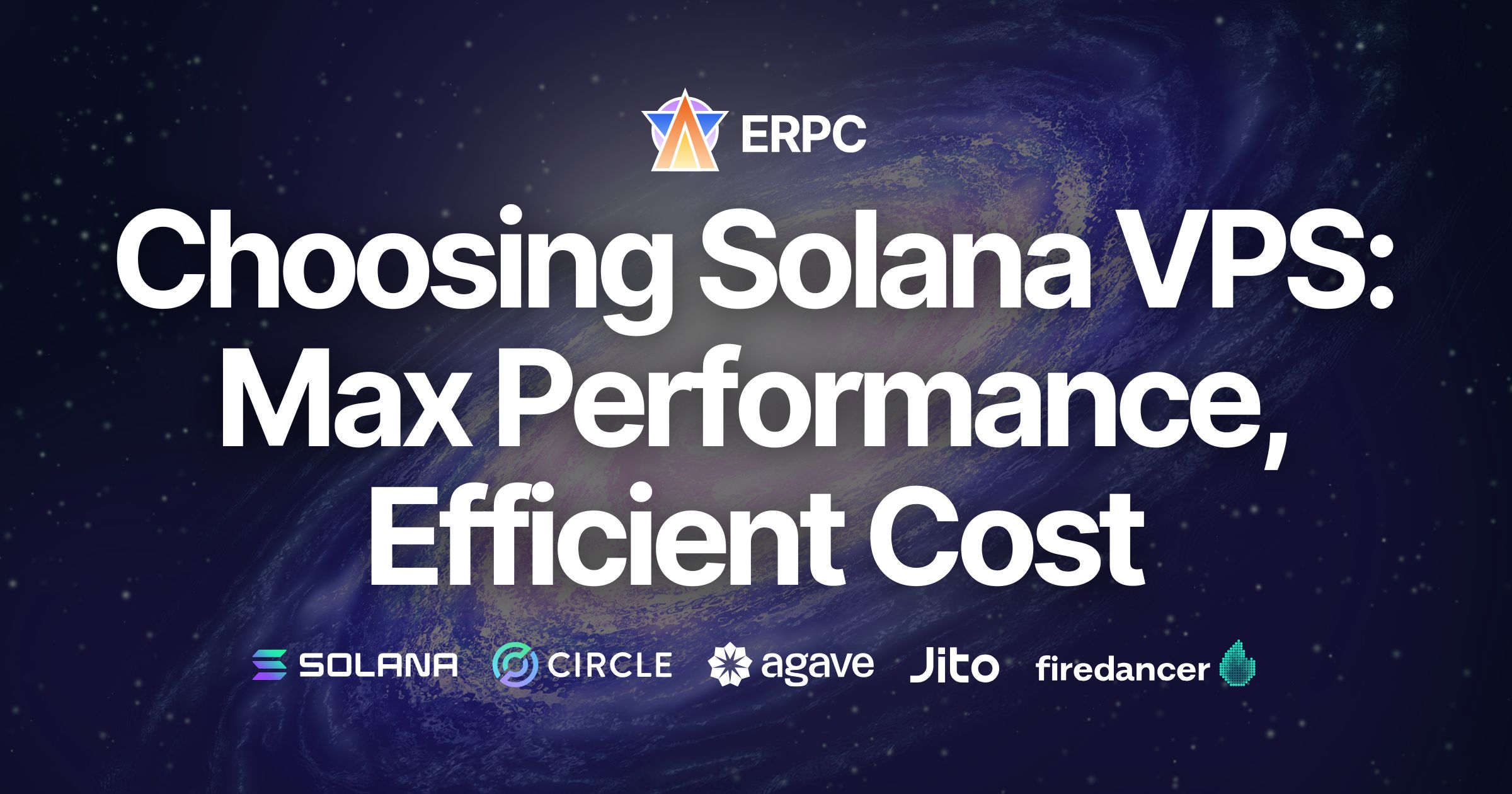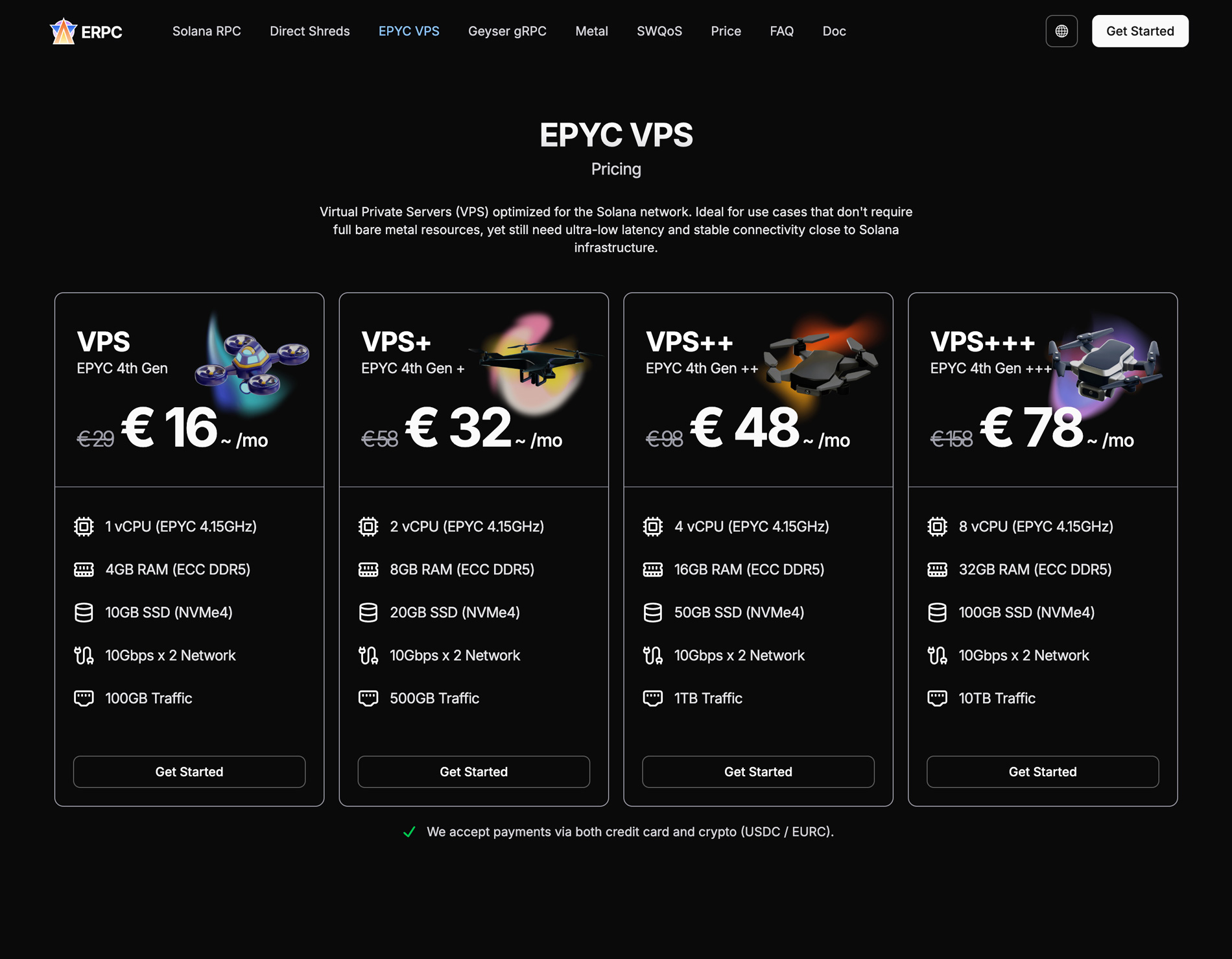How to Choose and Use a Solana VPS – Maximizing Performance While Controlling Costs
How to Choose and Use a Solana VPS – Maximizing Performance While Controlling Costs

Interest in Solana-based trading and new project launches is rapidly growing, and ERPC has seen a significant increase in inquiries as a result. However, financial expertise and server or computer knowledge are entirely separate domains, and many users struggle with selecting the right server specifications to execute their strategies effectively.
This guide is designed to clearly explain "How to choose a Solana VPS" and "How to maximize performance while controlling costs," even if you're not familiar with server technology.
CPU Generation and Clock Speed Matter Most: Don't Be Misled by Core Count or RAM Size
A common misunderstanding is that server performance can be judged purely by the numbers: CPU core count, RAM size, storage capacity, or network bandwidth. However, these figures alone don't accurately represent real-world performance.
Our research shows that the most critical factor for Solana environments is CPU clock speed (GHz). CPU clock speed significantly impacts performance not only for real-time applications but also tasks like snapshot downloads.
When choosing a VPS, first check the CPU's clock speed and its release date. The latest generation CPUs with higher clock speeds offer substantially better performance. Modern CPUs typically come with the latest RAM and storage technologies as well, so choosing based on the CPU ensures high overall server performance.
Understanding "Overcommitment": Real-World Testing Is Essential
VPS and virtual machine (VM) providers commonly use a technology called "overcommitment," where one physical server’s resources are shared among multiple users, based on the assumption that usage will be dispersed. However, some providers set excessively high overcommitment ratios, resulting in actual performance significantly lower than advertised.
Rather than relying solely on theoretical specifications, we strongly recommend testing multiple VPS options in your actual operational environment. Such real-world testing is particularly crucial for applications requiring real-time responsiveness.
Optimal Server Resource Management
To maximize cost-performance, ideally, keep CPU, RAM, and storage usage around 30-40%. Performance drops significantly when these resources reach 80% or higher.
Using monitoring tools like Prometheus and Grafana can help quickly identify and prevent performance degradation. These tools provide real-time visibility into resource usage, enabling optimal operation.
Important Considerations for Node.js Users
Node.js is popular for Solana application development but runs primarily on a single-threaded architecture. Therefore, deploying Node.js applications on multi-core servers can be wasteful and inefficient.
Typically, a Node.js application performs best on a server with just 1-2 cores. Rather than running multiple applications on a single, larger server, deploying them individually on smaller, dedicated VPS instances often yields superior performance.
While Node.js does have a built-in multi-threading feature called "cluster," managing inter-thread communication is challenging. For true multi-threaded capabilities, we recommend considering languages such as Rust.
Optimal Use of Rust
Rust provides excellent control over multi-threaded operations, making it ideal for performance optimization. However, Rust compilation requires significant resources.
The most efficient workflow involves developing Rust applications on your local machine or CI environment, then deploying only the compiled executable files to the VPS. Rust executables are lightweight and incredibly fast, allowing even small VPS instances (1-2 vCPU) to achieve exceptional performance, potentially reducing costs.
(The optimal approach depends on your specific use case. Highly skilled developers can leverage large-scale bare-metal servers effectively. However, breaking down workflows into smaller, optimized tasks generally simplifies maintenance, reduces costs, and enhances scalability.)
Advantages of Dividing Workflows Across Multiple VPS Instances
CPUs feature multi-level high-speed caches, delivering optimal performance when focused on a single task. Running diverse workloads on a single large server improves cost efficiency but reduces CPU performance due to cache inefficiencies.
For real-time applications or performance-critical workflows, splitting tasks across dedicated VPS instances usually delivers better outcomes. Conversely, consolidating less performance-sensitive workloads onto a single server can also be effective.
Why ERPC’s High-Performance VPS Is Recommended
ERPC operates its entire infrastructure within its own optimized network, minimizing the distance between VPS instances and dedicated Solana endpoints. This infrastructure delivers exceptionally low latency (~0.1ms), perfectly suited to Solana environments.
In particular, ERPC’s VPS solutions featuring the latest AMD EPYC CPUs offer high clock speeds combined with state-of-the-art hardware, delivering the highest possible performance within your budget.
We encourage you to try ERPC's EPYC VPS and experience the benefits firsthand in your Solana-based activities.

For detailed consultations or to request a free trial, please visit our Validators DAO official Discord:
Thank you for your continued support.
We look forward to continuously evolving ERPC to serve you better.




